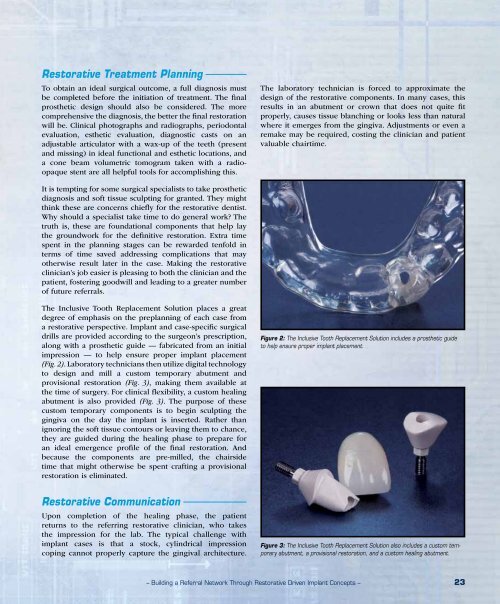PDF Download - Glidewell Dental Labs
PDF Download - Glidewell Dental Labs
PDF Download - Glidewell Dental Labs
You also want an ePaper? Increase the reach of your titles
YUMPU automatically turns print PDFs into web optimized ePapers that Google loves.
Restorative Treatment Planning<br />
To obtain an ideal surgical outcome, a full diagnosis must<br />
be completed before the initiation of treatment. The final<br />
prosthetic design should also be considered. The more<br />
comprehensive the diagnosis, the better the final restoration<br />
will be. Clinical photographs and radiographs, periodontal<br />
evaluation, esthetic evaluation, diagnostic casts on an<br />
adjustable articulator with a wax-up of the teeth (present<br />
and missing) in ideal functional and esthetic locations, and<br />
a cone beam volumetric tomogram taken with a radioopaque<br />
stent are all helpful tools for accomplishing this.<br />
The laboratory technician is forced to approximate the<br />
design of the restorative components. In many cases, this<br />
results in an abutment or crown that does not quite fit<br />
properly, causes tissue blanching or looks less than natural<br />
where it emerges from the gingiva. Adjustments or even a<br />
remake may be required, costing the clinician and patient<br />
valuable chairtime.<br />
It is tempting for some surgical specialists to take prosthetic<br />
diagnosis and soft tissue sculpting for granted. They might<br />
think these are concerns chiefly for the restorative dentist.<br />
Why should a specialist take time to do general work? The<br />
truth is, these are foundational components that help lay<br />
the groundwork for the definitive restoration. Extra time<br />
spent in the planning stages can be rewarded tenfold in<br />
terms of time saved addressing complications that may<br />
otherwise result later in the case. Making the restorative<br />
clinician’s job easier is pleasing to both the clinician and the<br />
patient, fostering goodwill and leading to a greater number<br />
of future referrals.<br />
The Inclusive Tooth Replacement Solution places a great<br />
degree of emphasis on the preplanning of each case from<br />
a restorative perspective. Implant and case-specific surgical<br />
drills are provided according to the surgeon’s prescription,<br />
along with a prosthetic guide — fabricated from an initial<br />
impression — to help ensure proper implant placement<br />
(Fig. 2). Laboratory technicians then utilize digital technology<br />
to design and mill a custom temporary abutment and<br />
provisional restoration (Fig. 3), making them available at<br />
the time of surgery. For clinical flexibility, a custom healing<br />
abutment is also provided (Fig. 3). The purpose of these<br />
custom temporary components is to begin sculpting the<br />
gingiva on the day the implant is inserted. Rather than<br />
ignoring the soft tissue contours or leaving them to chance,<br />
they are guided during the healing phase to prepare for<br />
an ideal emergence profile of the final restoration. And<br />
because the components are pre-milled, the chairside<br />
time that might otherwise be spent crafting a provisional<br />
restoration is eliminated.<br />
Figure 2: The Inclusive Tooth Replacement Solution includes a prosthetic guide<br />
to help ensure proper implant placement.<br />
Restorative Communication<br />
Upon completion of the healing phase, the patient<br />
returns to the referring restorative clinician, who takes<br />
the impression for the lab. The typical challenge with<br />
implant cases is that a stock, cylindrical impression<br />
coping cannot properly capture the gingival architecture.<br />
Figure 3: The Inclusive Tooth Replacement Solution also includes a custom temporary<br />
abutment, a provisional restoration, and a custom healing abutment.<br />
– Building a Referral Network Through Restorative Driven Implant Concepts – 23
















